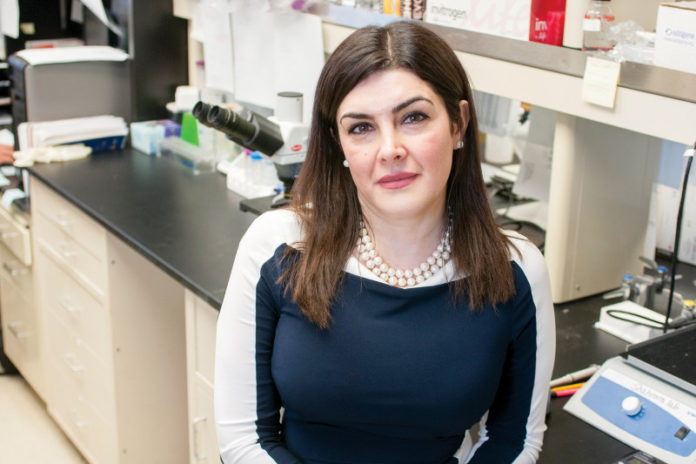
Researchers at the University of Illinois at Chicago College of Medicine have shown for the first time how the activation of a receptor provokes the inflammation and bone degradation of rheumatoid arthritis — and that activation of this one receptor, found on cells in the fluid of arthritic joints, is all that is required.
Their findings, published in the Journal of Immunology, point to a new therapeutic target to interrupt the vicious cycle of inflammation and bone erosion in rheumatoid arthritis.
Rheumatoid arthritis is a progressive autoimmune inflammatory disease of the joints. Swelling and pain, caused by certain cells flooding into the joints, is a hallmark of the disease, along with progressive bone loss. The UIC researchers have shown that the process begins with the triggering of a single receptor on a group of white blood cells.
“TLR5 does it all,” says Shiva Shahrara, UIC associate professor of rheumatology and corresponding author on the paper. TLR5, or toll-like receptor 5, is found on myeloid, or marrow-derived, cells that migrate from the blood into affected joints. Shahrara and her colleagues found that the receptor is much more abundant on myeloid cells found in the fluid of joints in patients with rheumatoid arthritis as compared to samples from healthy subjects.
In previous studies, Shahrara and her colleagues found that activation of TLR5 causes abnormal blood vessel formation in the joints of rheumatoid arthritis patients. In the new study they found that the receptor also up-regulates a potent inflammatory molecule called TNF-alpha, which recruits even more myeloid cells into the joint, where they are transformed into bone-degrading cells called osteoclasts.
In a series of experiments, the researchers uncovered multiple pathological processes driven by the activation of the receptor.
When the researchers placed TLR5-expressing myeloid cells next to joint fluid from rheumatoid arthritis patients, the cells migrated into the fluid. But if the receptor was blocked by an antibody, cell migration towards the fluid was significantly reduced. Something in the joint fluid attracts cells with TLR5, Shahrara said — perhaps TLR5’s binding protein, which is most likely present in joints affected by rheumatoid arthritis. The researchers also found that levels of TNF-alpha increased in joint fluid from patients with rheumatoid arthritis when myeloid cells with activated TLR5 were present.
Patients with rheumatoid arthritis who take anti-TNF-alpha drugs have lower levels of TLR5 on their myeloid cells, suggesting that a positive feedback loop exists between TLR5 and TNF-alpha, so that an elevation in one causes an increase in the other. “Not only do TLR5 and TNF-alpha regulate each other, but they work synergistically to attract more myeloid cells into the joint, where they are transformed into bone-eroding cells,” Shahrara said.
In a mouse model of rheumatoid arthritis, experimental mice given an antibody that blocked the TLR5 receptor had markedly reduced joint swelling and bone erosion compared to controls. The TLR5 antibody treatment may reduce swelling by lowering the number of myeloid cells migrating into the joints to become osteoclasts, the researchers said. Based on her studies in mice, Shahrara thinks a drug that prevents TLR5 activation could slow or prevent the inflammation and bone erosion of later-stage rheumatoid arthritis in patients.
“When TLR5 is activated, it initiates a vicious feedback loop that results in a worsening of both the inflammatory and erosive features of rheumatoid arthritis,” Shahrara said. “The receptor is a major driver of inflammation and bone degradation. Blocking this receptor could have significant therapeutic value in interrupting joint swelling and bone loss in patients with rheumatoid arthritis.”
Story Source:
The above story is based on materials provided by University of Illinois at Chicago. The original article was written by Sharon Parmet. Note: Materials may be edited for content and length.
Journal Reference:
- S.-j. Kim, Z. Chen, N. D. Chamberlain, A. B. Essani, M. V. Volin, M. A. Amin, S. Volkov, E. M. Gravallese, S. Arami, W. Swedler, N. E. Lane, A. Mehta, N. Sweiss, S. Shahrara. Ligation of TLR5 Promotes Myeloid Cell Infiltration and Differentiation into Mature Osteoclasts in Rheumatoid Arthritis and Experimental Arthritis. The Journal of Immunology, 2014; DOI: 10.4049/jimmunol.1302998
